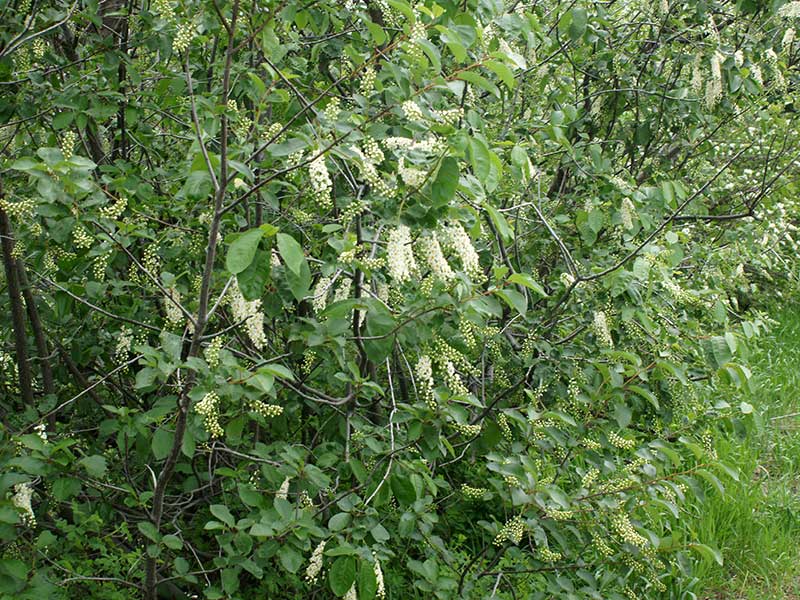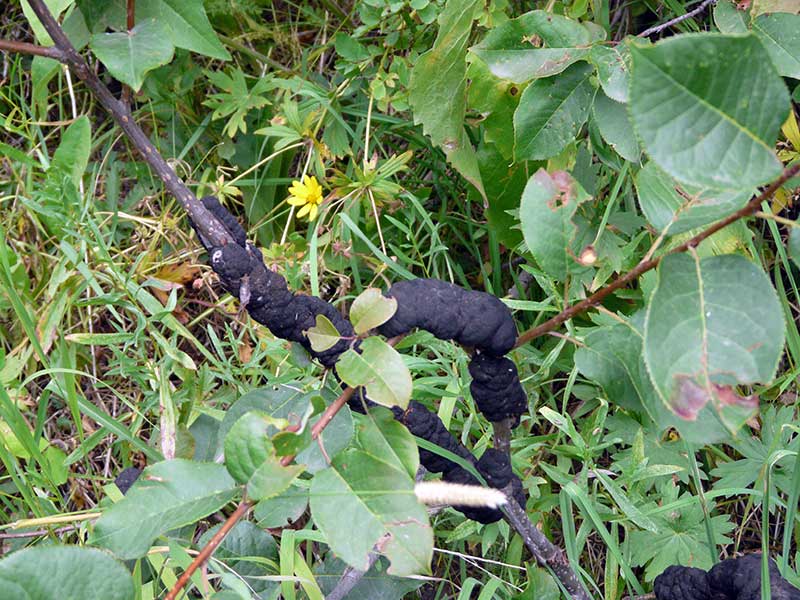Prunus virginiana / western chokecherry
- oval leaves with serrated margins and abrupt taper at tip
- reddish twigs with prominent lenticels
- drooping clumps of white flowers w/ yellow centers in spring
- red to black cherries in fall, up to ½ inch diameter
- leaves turn orange or yellow in fall
Also known as: bitter-berry, chokecherry, Virginia bird cherry, black chokecherry
Chokecherry is a suckering shrub or small tree growing to ca. 20 feet tall. It can spread clonally by rhizomes, often forming thickets. Chokecherry is one of the most common and ubiquitous trees/shrubs in North America. In addition to providing habitat for many animals, by clonal growth, it is instrumental in stabilizing stream banks.
The leaves of chokecherry are oval, up to 3.5 inches long, with serrated margins. They taper abruptly at the tip. The upper surface is dark green and glossy; the lower surface is lighter, often with white or yellowish hairs where the veins meet, especially when young. In autumn, the leaves turn golden yellow to orange.
The inflorescence of chokecherry is a nodding raceme. They appear in late spring. Each has 20 to 50 small flowers. The bloom starts after leaf emergence. Each flower has 5 spreading white petals, 5 sepals, many stamens, and a pistil with a single style. The centers of the flowers are yellow, especially as they age, this being the color of the old sepals. The flowers have an almond-sweet fragrance. Cyanide smells like almonds, too, and much of the plant is cyanogenic.
The fruits (drupes) are up to ½ inch in diameter, and range in color from bright red to black. They are astringent, i.e. sour and bitter, but get slightly sweeter as they ripen. Many animals, from the smallest mice to the largest bears, eat the fruits. It is also a favorite of birds which are instrumental in spreading the seeds.
Except in old wood, the bark is brown and smooth with prominent lenticels (lateral air pores).
Chokecherry is remarkably shade tolerant and has impressive resilience under variable growing conditions. Hence, it is widespread in the Valley. While it normally grows in wooded, rocky slopes, edges of forests, along streams, it is also a common shrub in residential areas.
Interesting bits – The wild chokecherry is often considered a pest, as it is a host for the tent caterpillar. Those are a threat to other fruit plants. Actually, it is also the larval (caterpillar) host to a wide variety of moths, so it isn’t all bad by any means.
Young growth, wilted leaves, or any parts that have been injured by frost or drought accrue cyanogenic compounds, i.e. they release cyanide when mixed with stomach acids. This makes them poisonous to cattle and humans. The seeds are also high in cyanogenic compounds. However, these can pass through the digestive systems of birds quickly, without releasing the cyanide.
Chokecherries are also affected by the pathogenic black knot fungus. So if you are walking on trails in the Valley, you may see these along the side. Check out the photo in the gallery.
| Color | |
|---|---|
| Family | |
| Blossom size | |
| Inflorescence size | |
| Inflorescence type | |
| When? | |
| Where? |




